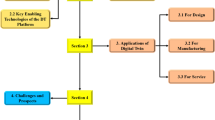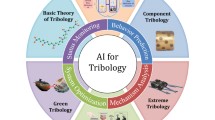Abstract
An interval discretization method (IDM) is proposed for the workspace determination of parallel mechanisms to address the fundamental problems of unreliable prediction and missing-points existing in the traditional point discretization method (PDM). The IDM involves two parts: the workspace prediction using interval analytical forward kinematics (AFK) and the workspace correction using interval analytical inverse kinematics (AIK). Three typical parallel mechanisms are adopted as illustrative examples, i.e., the planar four-bar mechanism, the spatial 9–3 and 12–6 parallel mechanisms. Firstly, the AFK and AIK of the mechanisms are derived and extended into interval-valued form. Then, the position and orientation workspaces are predicted and corrected in sequence. Finally, numerical behaviors of the proposed and traditional methods are compared. The numerical simulations in Matlab show that: (i) IDM is about 5.34 times faster than PDM; (ii) IDM is about 45.50 times more accurate than PDM; (iii) IDM is about 1.01 times more stable than PDM; and (iv) IDM can realize the prediction of position and orientation workspaces and has no missing-points, thereby demonstrating the effectiveness of the proposed method.



















Similar content being viewed by others
Availability of Data and Material
We will provide all data and materials if necessary.
References
Stewart, D.: A platform with six degrees of freedom. Proc. Inst. Mech. Eng. 180(15), 371–386 (1965). https://doi.org/10.1243/PIME_PROC_1965_180_029_02
You, J.J.; Xi, F.F.; Shen, H.P.; Wang, J.Y.; Yang, X.L.: A novel Stewart-type parallel mechanism with topological reconfiguration: design, kinematics and stiffness evaluation. Mech. Mach. Theory 162, 104329 (2021). https://doi.org/10.1016/j.mechmachtheory.2021.104329
Luces, M.; Mills, J.K.; Benhabib, B.: A review of redundant parallel kinematic mechanisms. J. Intell. Rob. Syst. 86, 175–198 (2017). https://doi.org/10.1007/s10846-016-0430-4
Nabavi, S.N.; Akbarzadeh, A.; Enferadi, J.: A study on kinematics and workspace determination of a general 6-PUS robot. J. Intell. Rob. Syst. 91, 351–362 (2018). https://doi.org/10.1007/s10846-017-0704-5
Xie, F.G.; Liu, X.J.; Wang, J.S.; Wabner, M.: Kinematic optimization of a five degree-of-freedom spatial parallel mechanism with large orientational workspace. ASME J. Mech. Robot. 9(5), 051005 (2017). https://doi.org/10.1115/1.4037254
Ye, P.D.; You, J.J.; Qiu, X.; Wang, L.K.; Li, C.G.; Ru, Y.: Status and development trend of motion performance in parallel robot. J. Nanjing Univ. of Aeron Astron 52(3), 363–377 (2020). https://doi.org/10.16356/j.1005-2615.2020.03.003
Gosselin, C.: Determination of the workspace of 6-DOF parallel manipulators. ASME J. Mech. Des. 112(3), 331–336 (1990). https://doi.org/10.1115/1.2912612
Kuzeci, Z.E.; Omurlu, V.E.; Alp, H.; Ozkol, I.: Workspace analysis of parallel mechanisms through neural networks and genetic algorithms. In: The 12th IEEE International Workshop on Advanced Motion Control, pp. 1–6. IEEE (2012). https://doi.org/10.1109/AMC.2012.6197147
Masory, O.; Wang, J.: Workspace evaluation of Stewart platforms. Adv. Robot. 9(4), 443–461 (1994). https://doi.org/10.1163/156855395X00508
Cao, Y.G.; Zhang, Y.R.; Ma, Y.Z.: Workspace analysis and parameter optimization of 6-RSS parallel mechanism. Chin. J. Mech. Eng. 44(1), 19–24 (2008). https://doi.org/10.3321/j.issn:0577-6686.2008.01.004
Yin, X.Q.; Zhao, G.H.; Ma, L.Z.: Workspace analysis of the end-effectors of Chinese massage robot. Chin. J. Eng. Des. 19(4), 302–306 (2012). https://doi.org/10.3785/j.issn.1006-754X.2012.04.012
Liu, Z.Z.; Liu, H.Y.; Luo, Z.; Zhang, X.H.: Improvement on Monte Carlo method for robot workspace determination. Trans. Chin. Soc. Agric. Mach. 44(1), 230–235 (2013). https://doi.org/10.6041/j.issn.1000-1298.2013.01.043
Merlet, J.P.: An improved design algorithm based on interval analysis for spatial parallel manipulator with specified workspace. In: Proceedings of the 2001 IEEE International Conference on Robotics & Automation, pp. 1289–1294. IEEE (2001). https://doi.org/10.1109/ROBOT.2001.932788
Chablat, D.; Wenger, P.; Majou, F.; Merlet, J.P.: An interval analysis based study for the design and the comparison of three-degrees-of-freedom parallel kinematic machines. Int. J. Robot. Res. 23(6), 615–624 (2004). https://doi.org/10.1177/0278364904044079
Oetomo, D.; Daney, D.; Shirinzadeh, B.; Merlet, J.P.: An interval-based method for workspace analysis of planar flexure-jointed mechanism. ASME J. Mech. Des. 131(1), 011014 (2009). https://doi.org/10.1115/1.3042151
Viegas, C.; Daney, D.; Tavakoli, M.; Almeida, A.T.: Performance analysis and design of parallel kinematic machines using interval analysis. Mech. Mach. Theory 115, 218–236 (2017). https://doi.org/10.1016/j.mechmachtheory.2017.05.003
FarzanehKaloorazi, M.H.; Masouleh, M.T.; Caro, S.: Collision-free workspace of parallel mechanisms based on an interval analysis approach. Robotica 35(8), 1747–1760 (2017). https://doi.org/10.1017/S0263574716000497
Cao, Y.; Lu, K.; Li, X.J.; Zang, Y.: Accurate numerical methods for computing 2D and 3D robot workspace. Int. J. Adv. Rob. Syst. 8(6), 1–13 (2011). https://doi.org/10.5772/45686
Zhao, Z.Y.; Xu, Z.B.; He, J.P.; He, S.; Xu, C.: Configuration optimization of nine degree of freedom super-redundant serial manipulator based on workspace analysis. J. Mech. Eng. 55(21), 51–63 (2019). https://doi.org/10.3901/JME.2019.21.051
Ye, P.D.; You, J.J.; Qiu, X.; Xu, S.; Wang, L.K.; Ru, Y.: Workspace analysis of Stewart derivative parallel robot. Machine Design and Research 36 (4), 47–51+61 (2020). https://doi.org/10.13952/j.cnki.jofmdr.2020.0145. (in Chinese)
Chaudhury, A.N.; Ghosal, A.: Optimum design of multi-degree-of-freedom closed-loop mechanisms and parallel manipulators for a prescribed workspace using Monte Carlo method. Mech. Mach. Theory 118, 115–138 (2017). https://doi.org/10.1016/j.mechmachtheory.2017.07.021
Li, C.G.; Wu, H.T.; You, J.J.: Redundant parallel six-axis accelerometer and measuring method. China. Patent CN101949954A
You, J.J.; Zuo, F.Y.; Yan, F.; Wang, J.; Wang, L.J.; Yan, P.F.: In-parallel platform and solution method of forward kinematics. China. Patent CN106142051A
Shen, H.P.; Li, J.; Wang, Z.; Meng, Q.M.; Dai, L.F.: Topology structure optimization and performance improvement for parallel mechanisms based on structure coupling-reducing and motion decoupling. J. Mech. Eng. 53(19), 176–186 (2017). https://doi.org/10.3901/JME.2017.19.176
Merlet, J.P.: Interval analysis and robotics. Robot. Res. 66, 147–156 (2010). https://doi.org/10.1007/978-3-642-14743-2_13
Moore, R.E.: Interval analysis. Prentice-Hall, Englewood Cliffs, N. J., USA. (1966). http://www.researchgate.net/publication/273129945_Interval_Analysis
Tannous, M.; Caro, S.; Goldsztejn, A.: Sensitivity analysis of parallel manipulators using an interval linearization method. Mech. Mach. Theory 71, 93–114 (2014). https://doi.org/10.1016/j.mechmachtheory.2013.09.004
You, J.J.; Wang, L.K.; Xi, F.F.; Shen, J.J.: Decoupling algorithm and maximum operation frequency of a novel parallel type six-axis accelerometer. IEEE Sens. J. 20(21), 12637–12651 (2020). https://doi.org/10.1109/JSEN.2020.3001250
Huang, L.; Li, Z.C.; Xie, F.; Feng, K.: Strapdown sculling velocity algorithms using novel input combinations. Math. Probl. Eng. 2018, 1–9 (2018). https://doi.org/10.1155/2018/9823138
Merlet, J.P.: Parallel robots. Springer Netherlands, Berlin, Germany. (2006). http://link.springer.com/book/10.1007%2F978-94-010-9587-7
Funding
This work was supported by an Oversea Study Fellowship from the China Scholarship Council (Grant No. 201908320035) and the National Natural Science Foundation of China (NSFC) (Grant No. 51405237).
Author information
Authors and Affiliations
Contributions
Jingjing You and Fengfeng Xi offered suggestions and reviewed the manuscript; Pengda Ye performed the simulation and wrote the manuscript; Jieyu Wang reviewed the manuscript; Yu Ru supervised all works.
Corresponding author
Ethics declarations
Conflict of interests
The authors declare that they have no conflict of interest.
Ethical Approval
There is no ethical issues in the research content.
Consent to Participate
All authors agreed to participate this research work.
Consent for Publication
All authors agreed to publish this research work.
Rights and permissions
About this article
Cite this article
Ye, P., You, J., Xi, F. et al. An Interval Discretization Method for Workspace Determination of Parallel Mechanisms. Arab J Sci Eng 47, 8805–8827 (2022). https://doi.org/10.1007/s13369-021-06310-2
Received:
Accepted:
Published:
Issue Date:
DOI: https://doi.org/10.1007/s13369-021-06310-2




